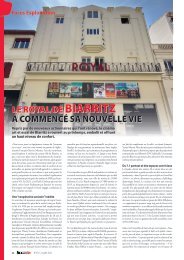Boxoffice-May.03.1952
Create successful ePaper yourself
Turn your PDF publications into a flip-book with our unique Google optimized e-Paper software.
j<br />
MEMOIRS OF PROGRESS<br />
Continued from page 36<br />
hold the crater as close as ten thousandths<br />
of an Inch of the exact focal point.<br />
Producins still more light meant developing<br />
still more heat. This called for a larger<br />
lamphouse. the redesigning for better dissipation,<br />
and the use of materials and parts<br />
which afforded greater resistance to heat.<br />
Forced air cooling was adopted for the<br />
working parts.<br />
A JET OF AIR WAS USED<br />
A jet of air, rather than the previously<br />
common magnetic system, was employed to<br />
stabilize the tail flame of the arc. This air<br />
blows the tail flame away from the reflector,<br />
keeps it cooler and prevents the soot<br />
from depositing on the surface.<br />
Here, in the Strong Mighty "90," developed<br />
in 1949. was a king size, reflectortype,<br />
high intensity projection arc lamp<br />
These old timers rep<br />
resent various stages<br />
of development in<br />
projectors and lamps<br />
At top left is the<br />
Powers Peerlesscope<br />
projector with acety<br />
lene<br />
projection<br />
lamp. At right is<br />
the Idison exhibition<br />
model of 1898 with<br />
a carbon arc lamp.<br />
The Phantascope<br />
projector and arc<br />
lamp produced by<br />
Jenkins is shown at<br />
the<br />
bottom.<br />
«« ••<br />
The Strong Mighty "90" was developed in 1949.<br />
It burns Irom 75 to 140 amperes, and produces<br />
all the light energy today's projectors and film<br />
can handle.<br />
that burned from 75 to 140 amperes and<br />
embodied all the advance engineering resulting<br />
from 25 years of building lamps.<br />
Here was a lamp that produced all the<br />
light energy that today's projectors and<br />
film could accept without damage to<br />
either or both.<br />
A SPOT FOR SMALL THEATRES<br />
Another follow spot, the Trouperette. employing<br />
the incandescent bulb instead of an<br />
arc, was designed in 1950 for the smaller<br />
theatres, night clubs and auditoriums where<br />
the tremendous volume of light from the<br />
arc was not necessary. This Trouperette<br />
employed the same ingenious optical system<br />
for changing the spot size that was<br />
used in the original Trouper arc follow spot.<br />
Celebrating the 30th anniversary of<br />
Strong Electric, this year is, more importantly,<br />
the 150th anniversary of Sir Humphry<br />
Davy's invention of the carbon arc.<br />
in w^hich he employed sticks of charcoal as<br />
electrodes and some wet batteries as a<br />
power supply. It was nearly 100 years later<br />
that Cecil Hepworth employed a hand-fed<br />
carbon arc on his Theatograph projector<br />
which was shortly followed by a vertical<br />
arc designed by Jenkins for use in his<br />
Phantascope projector.<br />
While arc lamps, because of their high<br />
intrinsic brilliancy, have always been used<br />
in motion picture projection, many other<br />
light sources have also been employed.<br />
Edison used an incandescent light in his<br />
Kinetoscope, but on his Exhibition Model<br />
of<br />
1898 adopted a carbon arc.<br />
FRENCHMEN USED ETHER LAMPS<br />
Auguste and Louis Lumiere of Lyon,<br />
F^-ance, used an ether lamp on their Cinematograph<br />
projector of 1895 and even today<br />
many of the old time projectionists will<br />
remember the first models of the celebrated<br />
Powers Peerlesscope projector which used<br />
an acetylene lamp. Thomas Drummond<br />
employed the lime light, which was simply<br />
a stick of lime heated to incandescence by<br />
a gas flame. Credit for the real improvement<br />
in projection lighting must go to<br />
Heinrich Beck of Meiningen, Germany, who<br />
40 years ago took out patents for an arc<br />
using a positive electrode, which was a<br />
carbon shell or tube filled with a paste,<br />
consisting of certain salts, fluorides of calcium,<br />
barium and strontium.<br />
When these electrodes were employed,<br />
this core material was changed into a gas<br />
which burned with a brilliancy that was<br />
many times that of the incandescent tip of<br />
a plain carbon electrode. Its snow-white<br />
color accounted for the name high intensity.<br />
An arc using plain carbons was known<br />
as a low intensity because it burned at a<br />
low color temperature, that is, a muddy<br />
yellow as compared with Beck's arc.<br />
It may be interesting to note that for the<br />
past 30 years Strong Electric has announced<br />
some major new development on the average<br />
of every two years. Our engineering<br />
department is constantly engaged in a program<br />
of experimentation, which will undoubtedly<br />
result in further developments<br />
to meet any needs of the future.<br />
As limelight and ether lamps were used<br />
in the early days of motion picture projection,<br />
likewise there have been recent<br />
experiments with higher-powered, incandescent,<br />
filament-type lamps; high pressure<br />
mercury lamps and zirconium electrode<br />
lamps, but none of these has ever approached<br />
the intrinsic brilliancy of the high<br />
intensity carbon arc.<br />
All the development and research work<br />
of the lamp manufacturers, collaborating<br />
with developments by the carbon companies,<br />
has resulted in improvements in<br />
lamp design, to a point where the light<br />
or energy at the film aperture is now so<br />
intense, that before any further increases<br />
in picture brilliancy can be attained there<br />
must necessarily be more effective methods<br />
of cooling the film at the aperture.<br />
MODELS TO MEET ANY NEED<br />
From a humble beginning. Strong Electric<br />
has grown to become the largest manufacturer<br />
of projection arc lamps in the<br />
world, with specific models to meet any<br />
field requirement.<br />
The Strong line includes the Mighty "90,"<br />
for use in the largest theatres and driveins:<br />
the Mogul for screens 24 feet in width;<br />
the Utility for 20-foot screens; the One<br />
Kilowatt lamp for screens of 18 feet in<br />
width; the Portable lamp for use with<br />
portable projectors, projecting pictures up<br />
to 14 feet in width, and the Junior High<br />
for 16mm projection.<br />
Strong engineers continually incorporate<br />
latest developments and improvements into<br />
each of these lamps, so that as they come<br />
off the production line today they are<br />
truly 1952 models.<br />
That's my story and I'm stuck with it.<br />
38 The MODERN THEATRE SECTION

















